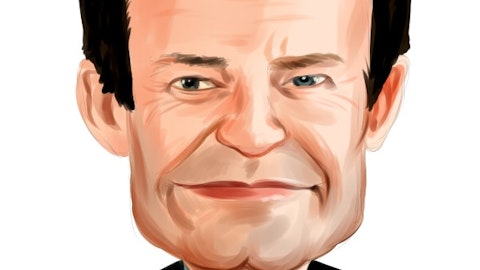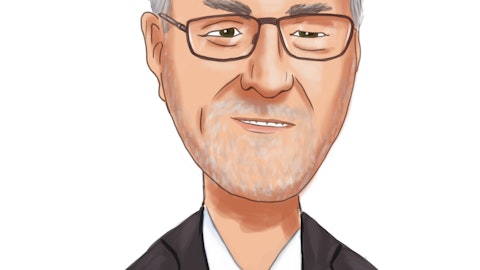Artisan Partners Asset Management Inc. (NYSE:APAM) Q4 2022 Earnings Call Transcript February 1, 2023
Operator: Hello, and thank you for standing by. My name is Drew, and I will be your conference operator today. At this time, all participants are in a listen-only mode. After the prepared remarks, management will conduct a question-and-answer session, and conference participants will be given instructions at that time. As a reminder, this conference call is being recorded. At this time, I will turn the call over to Artisan Partners Asset Management.
Makela Taphorn: Welcome to the Artisan Partners Asset Management Business Update and Earnings Call. Today’s call will include remarks from Eric Colson, CEO; and C.J. Daley, CFO. Following these remarks, we will open the line for questions. Our latest results and investor presentation are available on the Investor Relations section of our website. Before we begin, I would like to remind you that comments made on today’s call, including responses to questions, may deal with forward-looking statements. These are subject to risks and uncertainties and are presented in the earnings release and details in our SEC filings. We are not required to update or revise any of these statements following the call. In addition, some of our remarks today will include references to non-GAAP financial measures. You can find reconciliations of those measures to the most comparable GAAP measures in the earnings release. I will now turn the call over to Eric Colson.
Eric Colson: Thank you all for joining the call or reading the transcript. Outcomes in 2022 were difficult. For the year, our AUM declined from $175 billion to $128 billion, a 27% drop. Of our $9.8 billion of net outflows, more than $5 billion occurred in the fourth quarter, we experienced net outflows across majority of strategies and investment teams. For the year, our gross outflow rate was in line with our prior 10-year average. There was a broad array of reasons that clients rebalanced away with no single theme dominating. Lower gross inflows drove the net flow. Uncertainty, war, inflation, China, regulation paused decision making, especially allocations to risk assets. The market rebounded in the fourth quarter, especially in non-U.S. markets.
We believe decision-makers are learning to operate with greater uncertainty and has gathered more information and knowledge about direction of inflation and China policies. We don’t believe that our 2022 or fourth quarter flows will prove to be representative of net flows going forward. Today, we are particularly excited about fixed income as well as the dynamic for non-U.S. and global equities. With increases in rates and spreads, we see more excitement for fixed income today than any time since we launched our first fixed income strategy nearly nine years ago. We currently offer six high value-added fixed income strategies. We believe all of the strategies can and should capture some of the near-term demand for fixed income. The Artisan High Income, Floating Rate and Credit Opportunities strategies are managed by the Artisan Credit franchise, which I’ll discuss on the following slides.
The Artisan Emerging Markets Debt Opportunities, Emerging Markets Local Opportunities and Global Unconstrained strategies are managed by the EMsights Capital Group. EMsights Capital founders, Mike Cirami, Sarah Orvin and Mike O’Brien, have worked together for 14 years. They are well known in the marketplace, having built a well-regarded emerging market debt team at their prior firm. Last year, we built out the investment team, layered in technology, recruited business leadership and launched the three new strategies between March and July 2022. We expect all three strategies to experience early-stage growth this year, in particular, from institutional allocators willing to do deep diligence and capture the benefits of early adoption. We believe our two fixed income teams have great investments and business potential.
There is long-term secular demand for fixed income and credit-oriented strategies. Aging demographics demand yield and income. Investors and allocators will continue to allocate to fixed income for diversification and risk return benefits. There are large opportunity sets in which talented investment managers can differentiate from and outperform indexes and peers. Both the Credit team and the EMsights Capital Group have the experience, capabilities, breadth of resources and ambition to manage multiple strategies and generate significant revenue within the context of our larger business. Slide 2 summarizes the Artisan Credit franchise as it stands today. Since Bryan Krug joined Artisan Partners in 2013, we have partnered with him to methodically build out his team and establish a powerful investment franchise.
Today, the team possesses each of the franchise characteristics we seek: established leadership; a repeatable investment process; depth and breadth of resources, including people, networks and technology; proven results; economic alignment; a unique culture centered on the team’s Denver office; and an established brand. The Credit team has developed and evolved from an individual into a team into a franchise. Since inception in 2014, the Artisan High Income strategy has generated average annual returns of 5.1% after fees. The strategy has beat the benchmark index by an average of 178 basis points per year after fees. The Artisan High Income Fund is ranked Number 5 of 338 funds in the Lipper High Yield category. The team’s business has developed at a healthy pace during a period of muted flows for the high-yield asset class as a whole.
Cumulatively, the team has generated net flows of $7 billion, averaging approximately $750 million per year. Of the 167 mutual funds in the Morningstar high-yield category, Artisan’s High Income Fund has raised the third most since 2014. Slide 3 places the Credit franchise in broader Artisan historical context. The Credit team’s cumulative net flows over its first nine years are in line with those of other multi-generational, multi-strategy franchises. Credit AUM lags primarily due to the delta between credit and equity returns. Based on our historical experience, the credit team is right on schedule, both in terms of developing franchise characteristics and experiencing foundational business growth. Historically, we have seen foundational growth translate into a subsequent phase of compounding growth.
Investment teams compound existing capital at the same time, leveraging resources, returns and reputations to extend duration, diversify business and launch additional strategy. Two examples are our Growth and International Value teams, which today manage $34 billion and $30 billion, respectively, across a total of six investment strategies with multiple generations of decision-making leadership. Like foundational growth, compounding growth takes time. We prioritize existing client experience, and we thoughtfully manage capacity. For the Credit team, in the near-term, we expect continued growth and diversification across strategies and with institutional clients. Over the long-term, we expect the team to leverage their credit capabilities and investment networks to offer clients additional high value-added investment opportunities.
Bryan leads an already powerful franchise. They are still early in their journey. There is tremendous additional potential. Slide 4 summarizes the near-term opportunity in high-yield credit. Rates and spreads have widened, creating an attractive entry point for allocators and absolute return potential for investors. Index yield to worst is currently about 8%, much more attractive than the 4% to 6% range that has prevailed for much of the last decade. When yield spikes in 2016, the High Income Strategy generated a return of 35.4% between February 2016 and January 2018 gross of fees. When yields spiked in 2020, over the next 12 months, High Income generated a 31.5% return and Credit Opportunities generated a 58.5% return, both gross of fees. Not only is the entry point better from a yield perspective, greater price dispersion increases credit picking opportunities, more opportunities for the Credit team to generate convex returns in excess of expected yields.
What we see in the near term is alignment of the Credit team’s foundational growth and franchise characteristics with a more favorable investment environment, a combination that has us very excited. On my last slide, Slide 5, I want to come back to the equity environment. Of our 19 equity strategies, 11 focus on non-U.S., global or emerging markets. 75% of our total AUM is benchmarked against EAFE, Global or other non-U.S. indices. Approximately 55% of our equity AUM is invested in companies domiciled outside the U.S. Dating back to 1996 with the launch of Mark Yockey’s non-U.S. Growth Strategy, Artisan Partners has a long history of investing and adding value in international equity markets. Our eight non-U.S., global or EM strategies with track records of five years or more have beaten their indexes by an average of 289 basis points per year since inception after fees.
As I mentioned earlier, in the fourth quarter, non-U.S. equity significantly outperformed, driving the more than $12 billion of investment returns we generated in the quarter. Even with the strong fourth quarter performance, non-U.S. equities remain modestly valued by historical standards and relative to the S&P 500. We are not predicting mean reversion or calling the market, nearly pointing out that non-U.S. equities are attractively valued, and we have a long history of generating alpha in these markets. After a difficult year of outcomes, we are excited about what we can control, our investment lineup, both in equities and fixed income; our financial and economic model, which C.J. will elaborate on; our brand and reputation to attract proven investment talent and sophisticated clients.
We are optimistic about the current level of volatility and uncertainty; healthy security dispersion for active management, especially after a drawdown; greater clarity for risk-taking and decision-making; the ability to meet in person for due diligence and broaden our business development potential. I will now turn it over to C.J.
C.J. Daley: Thanks, Eric. 2022 follows on the heels of 2021, our most successful fiscal year ever in which we achieved record revenue and earnings. 2022 results, on the other hand, reflects the sharp decline in global markets and the impact of business investments made to support future growth. During the year, AUM declined from $175 billion to $128 billion. Revenues declined in line with the decrease in average AUM and were down 19%. As we often mention on these calls, our financial model was built to absorb volatile declines in global markets. And despite continuing to invest in long-term growth during 2022, our expenses were down 5% as a result of our model. Growth is not linear. AUM has grown 6% compounded annually, rising from $74 billion at the start of 2013 to $128 billion to end 2022.

Pixabay/Public Domain
Revenue has compounded annually by 7% and adjusted operating income by 5%. During this time, we diversified the business from five long-only equity investment teams, managing 12 strategies to a platform that now includes 10 investment teams and 25 strategies, managing assets in both public and private equities, fixed income and alternative asset classes. Our financial results over this period have enabled us to return cash dividends in excess of $32 per share to our shareholders since the IPO, including our recent declaration. Assets under management ended the fourth quarter at $127.9 billion, up 6% from the September 2022 quarter and down 27% from the prior December year-end. Investment returns contributed $12.8 billion to the increase in AUM in the quarter, partially offset by $5.2 billion of net client cash outflows and $300 million of annual Artisan Funds distributions that were not reinvested.
Average AUM for the quarter was down 4% sequentially and down 28% compared to the December 2021 quarter. For the full year, negative investment returns contributed $36.6 billion of the decrease in AUM and net client cash outflows lowered AUM by $9.8 billion. Average AUM for 2022 ended down 18% year-over-year. Across all generations, AUM was impacted by declining global markets and net client cash outflows. There were no material changes in the weighted average management fee or AUM mix by generation or vehicle. Financial results are presented on Slides 10 and 11. Our complete GAAP and adjusted results are presented in our earnings release. Quarterly revenues declined 4% compared to the previous quarter and 28% compared to the December 2021 quarter on lower average AUM.
For the full year, revenues were down 19% from 2021 on lower average AUM and lower performance fees. Performance fees were negligible in 2022 compared to $13.3 million in 2021. Adjusted operating expenses for the quarter decreased 1% sequentially due to the decline in incentive compensation expense as a result of lower revenues. Occupancy expense increased in the quarter as a result of a $1.4 million one-time charge taken on the abandonment of an office lease, a decision we made in part to trim costs. We will continue to look for ways to more efficiently use our office footprint as we adjust to the evolution of a hybrid work environment. For the year, adjusted operating expenses decreased 5% compared to 2021. The $74 million decline in incentive compensation expense was partially offset by increases in travel and expenses for headcount additions in 2021 and 2022, primarily base salaries and benefits.
A significant portion of the fixed cost increase from the prior year resulted from the launch of three strategies for our newest investment team. Adjusted operating income declined 8% for the quarter compared to the third quarter and declined 37% for the year compared to 2021. Likewise, adjusted net income per adjusted share declined 7% for the quarter compared to the third quarter and declined 38% for the year compared to 2021. Turning to Slide 12. Our balance sheet remains strong and continues to support our capital management needs and cash dividend policy. Our $100 million revolving credit facility remains unused. We continue to return capital to shareholders on a consistent and predictable basis through quarterly cash dividend payments and a year-end special dividend.
Consistent with our dividend policy, our Board of Directors declared a quarterly dividend of $0.55 per share with respect to the 2022 December quarter, which represents approximately 80% of the cash generated in the quarter. Our Board also declared a special annual dividend of $0.35 per share. Similar to last year, we retained a portion of cash generated in 2022 to fund future growth initiatives, primarily seed capital investments and new strategies and vehicles. Our seed capital investments at the end of the year were $125 million, up from $72 million a year ago, and represent investments in future growth, primarily in the fixed income and alternative space. Including this declaration, cash dividends of $2.82 per share will be paid with respect to 2022 cash generation, a payout of approximately 92%.
Calculated on a trailing 12-month period, this represents a yield of approximately 8%. Since our IPO, the average annual dividend yield has also been approximately 8%. Looking forward to the current year, each year, our Board of Directors approve a grant of long-term incentive awards. In the first quarter of 2023, the Board approved an award of approximately $57 million, consisting of $39 million of cash-based franchise capital awards and approximately $18 million of restricted stock awards. Generally, 50% of the award vests pro rata over five years and the remaining 50% vests on or after 18 months after a qualified retirement. We estimate the 2023 long-term incentive award amortization expense will be approximately $55 million. Fixed compensation costs are expected to rise approximately mid-single digits, reflecting 2023 merit increases, the absorption of a full year of expense for full-time employees hired in 2022 and an expected 5% increase in employees.
The additions will primarily be investments in distribution roles to support new and existing strategies. We also expect increases in technology and travel spend, resulting in a projected increase in fixed operating expenses of approximately 5% in 2023. Occupancy, long-term incentive compensation and other fixed operating expenses are expected to be relatively flat compared to 2022. The note refinancing that closed in August 2022 provides annual interest savings of $2.4 million and will reduce interest expense by $1.5 million in 2023 compared to 2022. And as a reminder, our compensation and benefits expenses are generally higher in the first quarter of each year due to seasonal expenses, which we estimate will be approximately $5 million higher in the first quarter of 2023 compared to the fourth quarter of 2022.
As Eric commented in his prepared remarks, we are optimistic that the investments we’ve made in our business over the past several years will lead to successful outcomes for our clients and shareholders. However, these outcomes will take time and will be lumpy. That concludes my prepared remarks. I will turn the call back to the operator.
See also 13 Best Communication Services Stocks To Invest In and 12 Best DRIP Stocks To Own.
Q&A Session
Follow Artisan Partners Asset Management Inc. (NYSE:APAM)
Follow Artisan Partners Asset Management Inc. (NYSE:APAM)
Operator: We will now begin the question-and-answer session. The first question comes from Alex Blostein with Goldman Sachs. Please go ahead.
Alex Blostein: Hi, good morning, guys. Thanks for the question. Eric, maybe we could start with a question around some of the opportunities you guys are seeing from a gross sales perspective for non-U.S. equities, including emerging market equities. Obviously, the markets are off to a good start this year. So, curious if you’re seeing an actual increase in RFPs and kind of active searches in that part of the market. And against that, you guys had a really strong 2020 and 2019 in terms of excess performance in those — in a number of the strategies, but a pretty challenging ’21 and ’22. So, as people kind of think about the longer-term track record like a three- and five-year basis, which is likely to get worse as some of the kind of prime vintages roll off, how does that impact the opportunity set to win some of these mandates?
Eric Colson: Yes. Thanks, Alex. The fourth quarter really highlighted some performance difference between non-U.S., emerging markets, China and some of the domestic indexes and we had a nice uplift in AUM, as we noted on the call. I think the backdrop on asset flow has been mixed bag. We’ve looked over the past couple of years to get some direction and looking forward, and it’s hard to extrapolate the trend line. We do see more activity in the marketplace with regards to due diligence than we’ve seen in the past couple of years, and we credit that to more of client research, consultant research, intermediary research, getting out and traveling again and conducting due diligence. And if you think about that, second half of 2020 into ’21, most people just allocated to their trusted partner, and we were a strong partner during that lockdown phase.
More recently, you’ve had the opening of due diligence, and we’ve picked up, and right now, we have a strong list of meetings for due diligence. But the trend line, I would say, is broader than just non-U.S. equities. Some clients are allocating to non-U.S. Other clients are still looking at growth value. Others are looking at active/passive. It’s that each client’s risk on and risk off has been different. And so, it really is hard for us to extrapolate any given year, especially last year when there was so much uncertainty in the market. I define that differently than just risk or volatility. I mean, uncertainties (ph) clients in what — where they need to go versus volatility and risk that you can understand a bit better and manage. So, we’re pleased about our non-U.S. strategies.
We’re pleased about where the market is at. And hope to get some direction from asset flows, but I’m hesitant to make that call and respond to you that there is a — that’s the major focus.
Alex Blostein: Got it. All right, thanks for that. C.J., maybe just a follow-up for you on expenses. When you take a step back and you look at the firm’s margins for the full year at around, I guess, 34% on a revenue base that is actually, I think, still a little bit above where you guys were in 2020, but the margins are down almost 500 basis points from that time. And taking your expense guidance, it feels like margins are going to be maybe under some pressure again into 2023. So, help us maybe think about that dynamic against the fairly variable expense structure as you described it in your prepared remarks. And what’s the path of kind of getting back to higher levels of operating leverage?
C.J. Daley: Yes. No. Thanks, Alex. Well, of course, as you know, you saw the strength of our model in the declining revenues of 2022, as revenues pulled back from the high levels in 2021, yet our expenses were still down 5%. That really was the benefit of our model, which pulled almost $80 million out of variable expenses without us announcing layoffs or bonus cuts, et cetera. Through that time, we invested heavily into our business. The EMsights team, which we onboarded, seeded four products with $60 million, continue to build out our infrastructure to support privates and our fixed income strategies. So, we have made a fair amount of investment over the last two years in people and systems to be able to look to the future and growth.
And now we’re pretty much situated to capitalize on those growth opportunities. And so, as we look into 2023, we’re really looking forward to just focusing on finishing what we’ve started on these growth opportunities and filling the capacity which likely is much greater than we’ve ever seen in our firm’s history. And now it’s just about executing on that and getting some help from the markets.
Alex Blostein: Got it. All right. Thanks.
Operator: The next question comes from Bill Katz with Credit Suisse. Please go ahead.
Bill Katz: Okay. Thank you very much as well for taking the question. Maybe just to come back to the discussion of an opportunity to sort of pickup of gross sales. Just a follow-up to Alex’s question. As you — given you have a strong brand, as you speak with your gatekeepers, whether it be on sort of the more affluent retail side or the institutional side, as you look at sort of the rolling one, three-year records, (ph) worse, but very robust five-plus years. Which is the bigger driver to that discussion? And could 2023 be a year where you get pretty good credit flows, but the equity book just sort of lags a little bit because of that interplay on the relative performance dynamics? Thank you.
Eric Colson: Hi, Bill. Yes, gross sales is our focus this year. As we noted in the call, our gross outflow has been hovering at the same rate for about 10 years, and I think our client service model is appropriately, it matches our product mix and our client mix. We have taken a look at the sales opportunities and looked back at last year, and we clearly had a lower sales rate, which created the higher-than-expected outflow. And as we look on a go-forward from a sales cycle, we are more so in past years, and you heard it in C.J.’s prepared remarks around expense management, but allowing some spend in the distribution and sales because we have the capacity and the strategies. We’ll be leaning into the sales team and looking to apply resources to take advantage of opportunities we see.
We certainly see the early stages of a new team with EMsights Capital Group and see strong interest in the institutional market, given the category, emerging market debt tends to be more dominated by institutional assets. The Credit team is clearly leaning into the institutional marketplace to diversify its asset base. And I think those could be very strong opportunities for the sales team. On the flip side, we got hit on the exchange of kicks of growth value, U.S., non-U.S., active/passive. We lost the exchanges in 2022. I don’t think that’s as easy to predict year-over-year in the short term. So, we’ll be interested to see how those exchange kicks occur, but we like our equity lineup with the focus on non-U.S., global and emerging markets, as we highlighted, and the trend line in performance.
So, hard to predict, Bill, but we’re optimistic in the mix of equity just as much as we are in fixed income.
Bill Katz: Got you. Okay. And just as a follow-up, sort of — your business has been sort of a little more incrementally geared to the institutional business. I think a lot of investors, as they look about the landscape are excited to sort of get into sort of the retail democratization opportunity and some of your assets certainly in that bucket. Can you talk a little bit about your plans to how to sort of go after the retail opportunity, if at all? Or is most of the incremental growth still going to be penetrating on the institutional side? Thank you.





